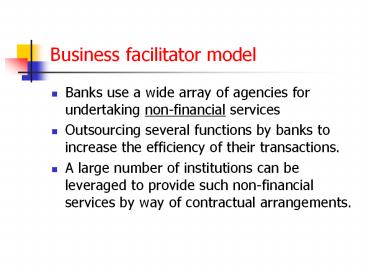Business facilitator model - PowerPoint PPT Presentation
Title:
Business facilitator model
Description:
Business facilitator model Banks use a wide array of agencies for undertaking non-financial services Outsourcing several functions by banks to increase the efficiency ... – PowerPoint PPT presentation
Number of Views:69
Avg rating:3.0/5.0
Title: Business facilitator model
1
Business facilitator model
- Banks use a wide array of agencies for
undertaking non-financial services - Outsourcing several functions by banks to
increase the efficiency of their transactions. - A large number of institutions can be leveraged
to provide such non-financial services by way of
contractual arrangements.
2
Non-financial Services
- Identification of borrowers
- Collection of application and verification of
primary information - Marketing of financial products
- Promoting SHGs/JLGs
- Post sanction monitoring
- Follow up for recovery
3
Business facilitator model
- Agencies include
- - NGOs
- - Functional cooperatives
- - Postal agents
- - Insurance agents
- - Agri clinics
- - Local youths/retired bank employees
4
Business Correspondent Model
- Use several institutions as agents for providing
financial functions on behalf of banks. - Function as pass through agents.
- Disbursal of small value credit
- Recovery of principal and interest
- The correspondent is authorized to accept/deliver
cash subject to the cap fixed by bank.
5
Issues
- Internal policy for identifying agencies
- Risk Management Strategies in the banks
- Rating of the agencies
- Due diligence to be carried out on the agencies
- Code of conduct for operation
- Monitoring and review arrangements
6
Selection criterion
- Significant rural presence
- Satisfactory dealing with banks
- Reference of third party known to bank
- Rating
- Due diligence
7
Due Diligence Indicative Parameters
- Charter and Registration
- - objectives of organization permit it to
undertake the proposed activities - Presence in the area
- Management and governance structure
- Manpower quality
- Accounting system
- Assessment of donors and peers
8
MFI-Bank Partnership Model
- MFI sources loans directly in the books of the
bank - MFI continues to monitor and recover loans thus
disbursed. - The NGO/MFI continues to perform the role of
social intermediary - The financial intermediation and therefore the
credit risk is left to the bank.
9
MFI-Bank Partnership Model
- This releases the MFIs from their capital
constraints and allows them to achieve rapid
increase in outreach. - The bank relies on the MFIs field operations for
collection and supervision. - MFI evaluates, recommends, originates the loans,
helps in disbursal and subsequently tracks and
collects the loans. - The MFI collects a service charge from the
borrowers to cover its transactions costs and
margins.
10
MFI-Bank Partnership Model
- Loan contracts directly between the bank and the
borrowers - - it does not reflect on the balance sheet of
the MFI - - The financial structure attempts to separate
the risk of the MFI from the risk of the
underlying portfolio.
11
MFI-Bank Partnership Model
- Alignment of incentives with a first loss
guarantee structure (FLDG) - -The financial structure requires the MFI to
provide a guarantee (a first loss default
guarantee) - - through FLDG the bank shares the risk of the
portfolio with the MFI up to a certain limit.
12
MFI-Bank Partnership Model
- FLDG makes the provider of the guarantee liable
to bear losses up to a certain specified limit,
say for the first 10 or 20 percent of loss on the
portfolio. - The quantum and pricing of the FLDG depend on the
operating capability and maturity of the MFI
13
MFI-Bank Partnership Model
- Transfer of implicit capital from the bank to the
MFI through an overdraft facility - - Along with advancing of credit to meet the
demand of the clients, the bank often provides an
overdraft (OD) facility to the MFI. - - The OD facility is equivalent to the amount
which the MFI is liable to provide as the FLDG.
14
MFI-Bank Partnership Model
- The OD is drawn only in the event of default.
- On default, the MFI is liable to pay a penal rate
of interest on the amount drawn down from the OD
facility.
15
MFI-Bank Partnership Model
- Partnership model and securitization
- - The microfinance assets originated under this
partnership model facilitate participation of a
wider investor base through the process of
securitization. - - sale of portfolio by the originating bank to
another bank
16
MFI-Bank Partnership Model
- When the microfinance pools become larger in
size, issuance of securities that are backed by
microfinance assets become conceivable. - The process catalyses development of a secondary
market for microfinance where some entities
specialize as originators and others emerge as
buyers/investors.
17
MFI-Bank Partnership Model
- The MFI also experiences rating arbitrage and the
improved rating results in lower costs of
financing.
18
MFI-Bank Partnership Model
- (i) lack of clarity with regard to the rights and
obligations of the MFIs vis-à-vis the banks since
although the MFI is responsible to ensure
recovery of loan, the loan documents are executed
by the ultimate borrowers in favour of the bank, - (ii) maturity mismatch between the repayment
schedule drawn by the bank vis-à-vis the MFI and
the repayment schedule between the ultimate
borrowers and the MFI, - (iii) the amount of fixed deposits collected as
margin from the MFI by the bank is often beyond
the financial capability of the MFI,
19
MFI-Bank Partnership Model
- (iv) imprudent selection of MFI as partner in a
bid to build up portfolio rapidly, and - (v) risk of multiple financing by more than one
bank.































